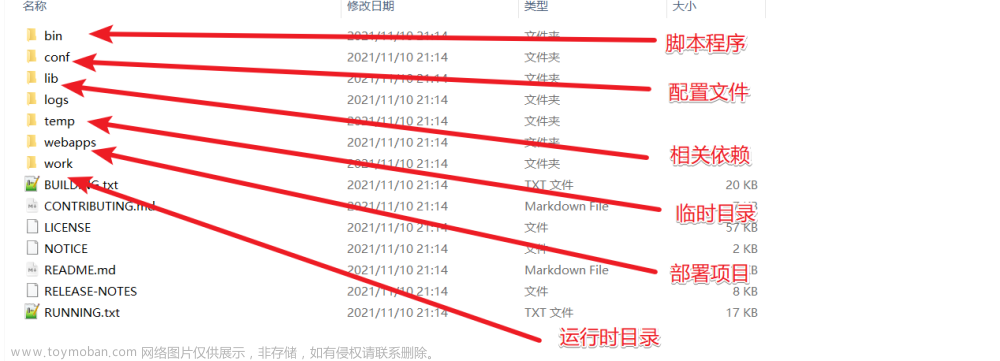一.前言
我们知道SpringBoot可以直接把传统的war包打成可执行的jar包,直接启动。这得益于SpringBoot内置了容器可以直接启动。本文将以 Tomcat 为例,来看看 SpringBoot 是如何启动 Tomcat 的。
二.源码分析
一.SpringApplication初始化
public class SpringBootDemoApplication {
public static void main(String[] args) {
SpringApplication.run(SpringBootDemoApplication.class, args);
}
}调用到最终的run方法我们来看一下
public static ConfigurableApplicationContext run(Class<?>[] primarySources, String[] args) {
return new SpringApplication(primarySources).run(args);
}这里面首先创建了一个SpringApplication的对象,然后调用了run方法,我们先看在创建对象的死后做了什么
public SpringApplication(ResourceLoader resourceLoader, Class<?>... primarySources) {
this.resourceLoader = resourceLoader;
Assert.notNull(primarySources, "PrimarySources must not be null");
this.primarySources = new LinkedHashSet<>(Arrays.asList(primarySources));
this.webApplicationType = WebApplicationType.deduceFromClasspath();
setInitializers((Collection) getSpringFactoriesInstances(ApplicationContextInitializer.class));
setListeners((Collection) getSpringFactoriesInstances(ApplicationListener.class));
this.mainApplicationClass = deduceMainApplicationClass();
}这里面对于我们有用的是WebApplicationType.deduceFromClasspath()方法,因为他返回了一个叫webApplicationType的东西。这个我们一会能用得到。看一下deduceFromClasspath()的源码
static WebApplicationType deduceFromClasspath() {
if (ClassUtils.isPresent(WEBFLUX_INDICATOR_CLASS, null) && !ClassUtils.isPresent(WEBMVC_INDICATOR_CLASS, null)
&& !ClassUtils.isPresent(JERSEY_INDICATOR_CLASS, null)) {
return WebApplicationType.REACTIVE;
}
for (String className : SERVLET_INDICATOR_CLASSES) {
if (!ClassUtils.isPresent(className, null)) {
return WebApplicationType.NONE;
}
}
return WebApplicationType.SERVLET;
}其中最主要的方法是ClassUtils.isPresent方法
public static boolean isPresent(String className, @Nullable ClassLoader classLoader) {
try {
forName(className, classLoader);
return true;
}
catch (IllegalAccessError err) {
throw new IllegalStateException("Readability mismatch in inheritance hierarchy of class [" +
className + "]: " + err.getMessage(), err);
}
catch (Throwable ex) {
// Typically ClassNotFoundException or NoClassDefFoundError...
return false;
}
}可以看到就是利用反射来判断传入的className是否存在,如果不存在返回false.
最后this.webApplicationType= WebApplicationType.SERVLET这个东东。
至于其他忽略的源码,之后会在其他源码分析模块讲解
二.run方法的调用
public ConfigurableApplicationContext run(String... args) {
StopWatch stopWatch = new StopWatch();
stopWatch.start();
ConfigurableApplicationContext context = null;
Collection<SpringBootExceptionReporter> exceptionReporters = new ArrayList<>();
configureHeadlessProperty();
SpringApplicationRunListeners listeners = getRunListeners(args);
listeners.starting();
try {
ApplicationArguments applicationArguments = new DefaultApplicationArguments(args);
ConfigurableEnvironment environment = prepareEnvironment(listeners, applicationArguments);
configureIgnoreBeanInfo(environment);
Banner printedBanner = printBanner(environment);
context = createApplicationContext();
exceptionReporters = getSpringFactoriesInstances(SpringBootExceptionReporter.class,
new Class[] { ConfigurableApplicationContext.class }, context);
prepareContext(context, environment, listeners, applicationArguments, printedBanner);
refreshContext(context);
afterRefresh(context, applicationArguments);
stopWatch.stop();
if (this.logStartupInfo) {
new StartupInfoLogger(this.mainApplicationClass).logStarted(getApplicationLog(), stopWatch);
}
listeners.started(context);
callRunners(context, applicationArguments);
}
catch (Throwable ex) {
handleRunFailure(context, ex, exceptionReporters, listeners);
throw new IllegalStateException(ex);
}
try {
listeners.running(context);
}
catch (Throwable ex) {
handleRunFailure(context, ex, exceptionReporters, null);
throw new IllegalStateException(ex);
}
return context;
}这里面对于我们相关的有两个方法一个是context = createApplicationContext();方法,另一个是refreshContext(context)方法,我们分别分析一下源码。
(1)createApplicationContext()
protected ConfigurableApplicationContext createApplicationContext() {
Class<?> contextClass = this.applicationContextClass;
if (contextClass == null) {
try {
switch (this.webApplicationType) {
case SERVLET:
contextClass = Class.forName(DEFAULT_SERVLET_WEB_CONTEXT_CLASS);
break;
case REACTIVE:
contextClass = Class.forName(DEFAULT_REACTIVE_WEB_CONTEXT_CLASS);
break;
default:
contextClass = Class.forName(DEFAULT_CONTEXT_CLASS);
}
}
catch (ClassNotFoundException ex) {
throw new IllegalStateException(
"Unable create a default ApplicationContext, please specify an ApplicationContextClass", ex);
}
}
return (ConfigurableApplicationContext) BeanUtils.instantiateClass(contextClass);
}还记得我们上一部分返回的this.webApplicationType的值是什么么?是Servlet对吧。
那么返回的contextClass就是对应的DEFAULT_SERVLET_WEB_CONTEXT_CLASS值也就是
public static final String DEFAULT_SERVLET_WEB_CONTEXT_CLASS = "org.springframework.boot." + "web.servlet.context.AnnotationConfigServletWebServerApplicationContext";
这里就是根据我们的 webApplicationType 来判断创建哪种类型的 Servlet,代码中分别对应着 Web 类型(SERVLET),响应式 Web 类型(REACTIVE),非 Web 类型(default),我们建立的是 Web 类型,所以肯定实例化 DEFAULT_SERVLET_WEB_CONTEXT_CLASS 指定的类,也就是 AnnotationConfigServletWebServerApplicationContext 类,我们来用图来说明下这个类的关系
我们看一下返回回来的ConfigurableApplicationContext 发现他是一个接口。因为我们是AnnotationConfigServletWebServerApplicationContext。是他的实现类,所以我们自然而然进入到AnnotationConfigServletWebServerApplicationContext中

这是他的类的关系 可以发现最后继承的是AbstractApplicationContext。至此创建线程上线文完成。回过头我们来看一下refreshContext()方法
(2)refreshContext()方法
我们跟随代码来到
private void refreshContext(ConfigurableApplicationContext context) {
refresh(context);
if (this.registerShutdownHook) {
try {
context.registerShutdownHook();
}
catch (AccessControlException ex) {
// Not allowed in some environments.
}
}
}这块还是调用的本方法的refresh方法最后强转成AbstractApplicationContext,调用它的refresh()方法
protected void refresh(ApplicationContext applicationContext) {
Assert.isInstanceOf(AbstractApplicationContext.class, applicationContext);
((AbstractApplicationContext) applicationContext).refresh();
}public void refresh() throws BeansException, IllegalStateException {
synchronized (this.startupShutdownMonitor) {
// Prepare this context for refreshing.
prepareRefresh();
// Tell the subclass to refresh the internal bean factory.
ConfigurableListableBeanFactory beanFactory = obtainFreshBeanFactory();
// Prepare the bean factory for use in this context.
prepareBeanFactory(beanFactory);
try {
// Allows post-processing of the bean factory in context subclasses.
postProcessBeanFactory(beanFactory);
// Invoke factory processors registered as beans in the context.
invokeBeanFactoryPostProcessors(beanFactory);
// Register bean processors that intercept bean creation.
registerBeanPostProcessors(beanFactory);
// Initialize message source for this context.
initMessageSource();
// Initialize event multicaster for this context.
initApplicationEventMulticaster();
// Initialize other special beans in specific context subclasses.
onRefresh();
// Check for listener beans and register them.
registerListeners();
// Instantiate all remaining (non-lazy-init) singletons.
finishBeanFactoryInitialization(beanFactory);
// Last step: publish corresponding event.
finishRefresh();
}
catch (BeansException ex) {
if (logger.isWarnEnabled()) {
logger.warn("Exception encountered during context initialization - " +
"cancelling refresh attempt: " + ex);
}
// Destroy already created singletons to avoid dangling resources.
destroyBeans();
// Reset 'active' flag.
cancelRefresh(ex);
// Propagate exception to caller.
throw ex;
}
finally {
// Reset common introspection caches in Spring's core, since we
// might not ever need metadata for singleton beans anymore...
resetCommonCaches();
}
}
}这里我们看到 onRefresh()方法是调用其子类的实现,根据我们上文的分析,我们这里的子类是 ServletWebServerApplicationContext。
调用的是这个ServletWebServerApplicationContext类的onRefresh()方法()
protected void onRefresh() {
super.onRefresh();
try {
createWebServer();
}
catch (Throwable ex) {
throw new ApplicationContextException("Unable to start web server", ex);
}
}关键代码在于createWebServer();
private void createWebServer() {
WebServer webServer = this.webServer;
ServletContext servletContext = getServletContext();
if (webServer == null && servletContext == null) {
ServletWebServerFactory factory = getWebServerFactory();
this.webServer = factory.getWebServer(getSelfInitializer());
}
else if (servletContext != null) {
try {
getSelfInitializer().onStartup(servletContext);
}
catch (ServletException ex) {
throw new ApplicationContextException("Cannot initialize servlet context", ex);
}
}
initPropertySources();
}这就是创建WebServer的意思,其中最重要的就是通过getWebServerFactory()方法来获取webserver,我们来看一下。

看见了么?这个工厂接口有下面这几种实现类,根据上图我们发现,工厂类是一个接口,各个具体服务的实现是由各个子类来实现的,所以我们就去看看 TomcatServletWebServerFactory.getWebServer()的实现。
@Override
public WebServer getWebServer(ServletContextInitializer... initializers) {
if (this.disableMBeanRegistry) {
Registry.disableRegistry();
}
Tomcat tomcat = new Tomcat();
File baseDir = (this.baseDirectory != null) ? this.baseDirectory : createTempDir("tomcat");
tomcat.setBaseDir(baseDir.getAbsolutePath());
Connector connector = new Connector(this.protocol);
connector.setThrowOnFailure(true);
tomcat.getService().addConnector(connector);
customizeConnector(connector);
tomcat.setConnector(connector);
tomcat.getHost().setAutoDeploy(false);
configureEngine(tomcat.getEngine());
for (Connector additionalConnector : this.additionalTomcatConnectors) {
tomcat.getService().addConnector(additionalConnector);
}
prepareContext(tomcat.getHost(), initializers);
return getTomcatWebServer(tomcat);
}总结
SpringBoot 的启动是通过 new SpringApplication()实例来启动的,启动过程主要做如下几件事情:> 1. 配置属性 > 2. 获取监听器,发布应用开始启动事件 > 3. 初始化输入参数 > 4. 配置环境,输出 banner > 5. 创建上下文 > 6. 预处理上下文 > 7. 刷新上下文 > 8. 再刷新上下文 > 9. 发布应用已经启动事件 > 10. 发布应用启动完成事件文章来源:https://www.toymoban.com/news/detail-452674.html
而启动 Tomcat 就是在第 7 步中“刷新上下文”;文章来源地址https://www.toymoban.com/news/detail-452674.html
到了这里,关于SpringBoot源码分析之Tomcat是如何在SpringBoot中启动的?的文章就介绍完了。如果您还想了解更多内容,请在右上角搜索TOY模板网以前的文章或继续浏览下面的相关文章,希望大家以后多多支持TOY模板网!













